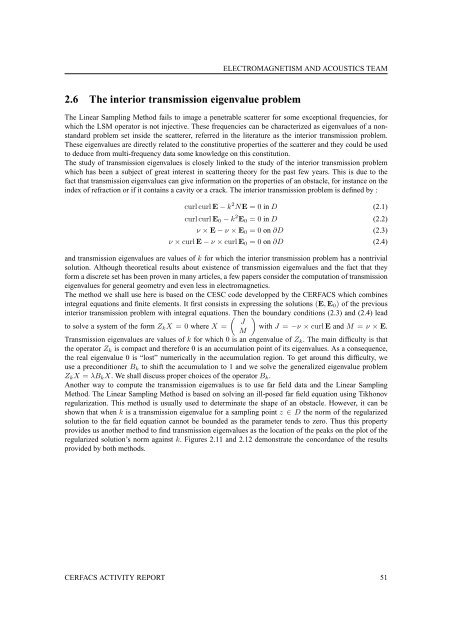CERFACS CERFACS Scientific Activity Report Jan. 2010 â Dec. 2011
CERFACS CERFACS Scientific Activity Report Jan. 2010 â Dec. 2011
CERFACS CERFACS Scientific Activity Report Jan. 2010 â Dec. 2011
Create successful ePaper yourself
Turn your PDF publications into a flip-book with our unique Google optimized e-Paper software.
ELECTROMAGNETISM AND ACOUSTICS TEAM<br />
2.6 The interior transmission eigenvalue problem<br />
The Linear Sampling Method fails to image a penetrable scatterer for some exceptional frequencies, for<br />
which the LSM operator is not injective. These frequencies can be characterized as eigenvalues of a nonstandard<br />
problem set inside the scatterer, referred in the literature as the interior transmission problem.<br />
These eigenvalues are directly related to the constitutive properties of the scatterer and they could be used<br />
to deduce from multi-frequency data some knowledge on this constitution.<br />
The study of transmission eigenvalues is closely linked to the study of the interior transmission problem<br />
which has been a subject of great interest in scattering theory for the past few years. This is due to the<br />
fact that transmission eigenvalues can give information on the properties of an obstacle, for instance on the<br />
index of refraction or if it contains a cavity or a crack. The interior transmission problem is defined by :<br />
curlcurlE − k 2 NE = 0 in D (2.1)<br />
curlcurlE 0 − k 2 E 0 = 0 in D (2.2)<br />
ν × E − ν × E 0 = 0 on ∂D (2.3)<br />
ν × curlE − ν × curlE 0 = 0 on ∂D (2.4)<br />
and transmission eigenvalues are values of k for which the interior transmission problem has a nontrivial<br />
solution. Although theoretical results about existence of transmission eigenvalues and the fact that they<br />
form a discrete set has been proven in many articles, a few papers consider the computation of transmission<br />
eigenvalues for general geometry and even less in electromagnetics.<br />
The method we shall use here is based on the CESC code developped by the <strong>CERFACS</strong> which combines<br />
integral equations and finite elements. It first consists in expressing the solutions (E,E 0 ) of the previous<br />
interior transmission problem with integral equations. ( Then the ) boundary conditions (2.3) and (2.4) lead<br />
J<br />
to solve a system of the form Z k X = 0 where X = with J = −ν × curlE and M = ν × E.<br />
M<br />
Transmission eigenvalues are values of k for which 0 is an engenvalue of Z k . The main difficulty is that<br />
the operator Z k is compact and therefore 0 is an accumulation point of its eigenvalues. As a consequence,<br />
the real eigenvalue 0 is “lost” numerically in the accumulation region. To get around this difficulty, we<br />
use a preconditioner B k to shift the accumulation to 1 and we solve the generalized eigenvalue problem<br />
Z k X = λB k X. We shall discuss proper choices of the operator B k .<br />
Another way to compute the transmission eigenvalues is to use far field data and the Linear Sampling<br />
Method. The Linear Sampling Method is based on solving an ill-posed far field equation using Tikhonov<br />
regularization. This method is usually used to determinate the shape of an obstacle. However, it can be<br />
shown that when k is a transmission eigenvalue for a sampling point z ∈ D the norm of the regularized<br />
solution to the far field equation cannot be bounded as the parameter tends to zero. Thus this property<br />
provides us another method to find transmission eigenvalues as the location of the peaks on the plot of the<br />
regularized solution’s norm against k. Figures 2.11 and 2.12 demonstrate the concordance of the results<br />
provided by both methods.<br />
<strong>CERFACS</strong> ACTIVITY REPORT 51
















